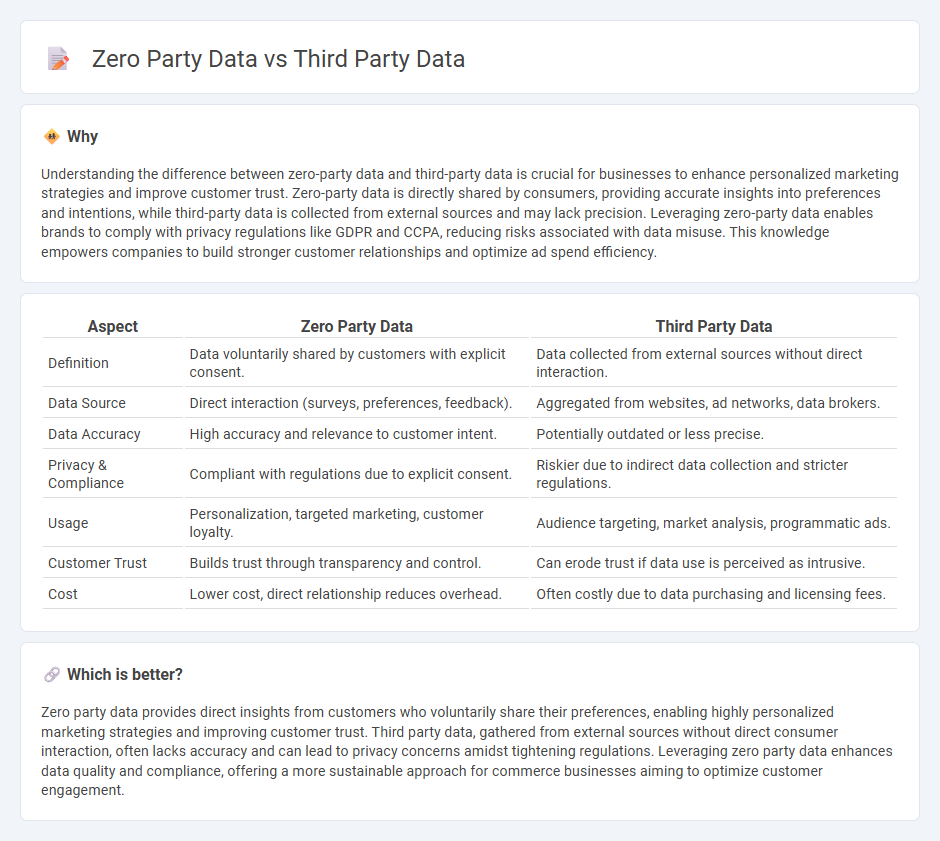
Zero party data refers to information that customers intentionally and proactively share with a brand, such as preferences and feedback, allowing for highly personalized and trust-based marketing. In contrast, third party data is collected anonymously from external sources without direct interaction with the user, often aggregating behavioral data from multiple platforms and posing privacy concerns. Explore the differences between zero party and third party data to enhance your commerce strategy effectively.
Why it is important
Understanding the difference between zero-party data and third-party data is crucial for businesses to enhance personalized marketing strategies and improve customer trust. Zero-party data is directly shared by consumers, providing accurate insights into preferences and intentions, while third-party data is collected from external sources and may lack precision. Leveraging zero-party data enables brands to comply with privacy regulations like GDPR and CCPA, reducing risks associated with data misuse. This knowledge empowers companies to build stronger customer relationships and optimize ad spend efficiency.
Comparison Table
| Aspect | Zero Party Data | Third Party Data |
|---|---|---|
| Definition | Data voluntarily shared by customers with explicit consent. | Data collected from external sources without direct interaction. |
| Data Source | Direct interaction (surveys, preferences, feedback). | Aggregated from websites, ad networks, data brokers. |
| Data Accuracy | High accuracy and relevance to customer intent. | Potentially outdated or less precise. |
| Privacy & Compliance | Compliant with regulations due to explicit consent. | Riskier due to indirect data collection and stricter regulations. |
| Usage | Personalization, targeted marketing, customer loyalty. | Audience targeting, market analysis, programmatic ads. |
| Customer Trust | Builds trust through transparency and control. | Can erode trust if data use is perceived as intrusive. |
| Cost | Lower cost, direct relationship reduces overhead. | Often costly due to data purchasing and licensing fees. |
Which is better?
Zero party data provides direct insights from customers who voluntarily share their preferences, enabling highly personalized marketing strategies and improving customer trust. Third party data, gathered from external sources without direct consumer interaction, often lacks accuracy and can lead to privacy concerns amidst tightening regulations. Leveraging zero party data enhances data quality and compliance, offering a more sustainable approach for commerce businesses aiming to optimize customer engagement.
Connection
Zero party data, collected directly from consumers through surveys and preferences, provides businesses with explicit insights into customer desires and intentions. Third party data, aggregated from external sources, enriches this information by offering broader demographic and behavioral context. Integrating zero party data with third party data enables commerce platforms to create highly personalized marketing strategies, improving customer engagement and conversion rates.
Key Terms
Data Ownership
Third party data is collected and owned by external entities, often aggregating consumer information without direct interaction, leading to limited control and privacy concerns for the user. Zero party data is voluntarily shared by consumers directly with brands, ensuring full transparency, ownership, and personalized engagement opportunities. Explore how shifting towards zero party data empowers businesses with genuine consumer insights and stronger data ownership.
Consent
Third party data involves information collected by external entities without direct consumer interaction, often raising complex consent issues under regulations like GDPR and CCPA. Zero party data is voluntarily shared by consumers, ensuring explicit consent and fostering trust and transparency in data usage. Explore more to understand how prioritizing consent can enhance data strategies and compliance.
Personalization
Third party data is aggregated from external sources and offers broad insights for personalization but often lacks specificity and consent, impacting user trust. Zero party data, voluntarily shared directly by customers, provides highly accurate and privacy-compliant personalization opportunities, enhancing customer engagement and satisfaction. Explore the benefits and challenges of both data types to optimize your personalization strategy effectively.
Source and External Links
What Is First-Party Data and Third-Party Data? Expert Guide - Third-party data refers to information collected and aggregated by external sources or data providers from various origins such as public records, surveys, and transaction histories, then packaged for businesses to use in marketing and audience targeting efforts.
Third-party data | Acxiom - Third-party data is customer information lawfully collected by data providers with no direct customer relationship, used by brands to better understand, segment, and personalize customer engagement, and distinct from first-party, second-party, and zero-party data types.
First, Second and Third-Party Data: How Are They Different? - Third-party data is acquired from aggregators who compile it from multiple sources into large datasets, often purchased via DSPs or DMPs, allowing broad advertising reach and improved targeting when combined with first-party data, though its accuracy and compliance needs careful vetting.
 dowidth.com
dowidth.com